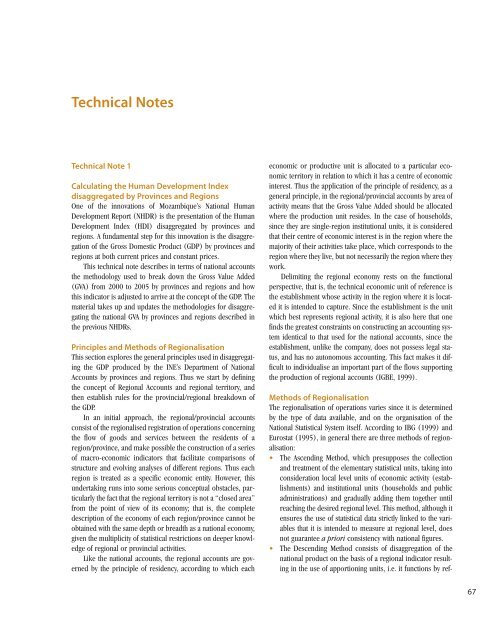English language version - Human Development Reports - United ...
English language version - Human Development Reports - United ...
English language version - Human Development Reports - United ...
- No tags were found...
You also want an ePaper? Increase the reach of your titles
YUMPU automatically turns print PDFs into web optimized ePapers that Google loves.
Technical NotesTechnical Note 1Calculating the <strong>Human</strong> <strong>Development</strong> Indexdisaggregated by Provinces and RegionsOne of the innovations of Mozambique’s National <strong>Human</strong><strong>Development</strong> Report (NHDR) is the presentation of the <strong>Human</strong><strong>Development</strong> Index (HDI) disaggregated by provinces andregions. A fundamental step for this innovation is the disaggregationof the Gross Domestic Product (GDP) by provinces andregions at both current prices and constant prices.This technical note describes in terms of national accountsthe methodology used to break down the Gross Value Added(GVA) from 2000 to 2005 by provinces and regions and howthis indicator is adjusted to arrive at the concept of the GDP. Thematerial takes up and updates the methodologies for disaggregatingthe national GVA by provinces and regions described inthe previous NHDRs.Principles and Methods of RegionalisationThis section explores the general principles used in disaggregatingthe GDP produced by the INE’s Department of NationalAccounts by provinces and regions. Thus we start by definingthe concept of Regional Accounts and regional territory, andthen establish rules for the provincial/regional breakdown ofthe GDP.In an initial approach, the regional/provincial accountsconsist of the regionalised registration of operations concerningthe flow of goods and services between the residents of aregion/province, and make possible the construction of a seriesof macro-economic indicators that facilitate comparisons ofstructure and evolving analyses of different regions. Thus eachregion is treated as a specific economic entity. However, thisundertaking runs into some serious conceptual obstacles, particularlythe fact that the regional territory is not a “closed area”from the point of view of its economy; that is, the completedescription of the economy of each region/province cannot beobtained with the same depth or breadth as a national economy,given the multiplicity of statistical restrictions on deeper knowledgeof regional or provincial activities.Like the national accounts, the regional accounts are governedby the principle of residency, according to which eacheconomic or productive unit is allocated to a particular economicterritory in relation to which it has a centre of economicinterest. Thus the application of the principle of residency, as ageneral principle, in the regional/provincial accounts by area ofactivity means that the Gross Value Added should be allocatedwhere the production unit resides. In the case of households,since they are single-region institutional units, it is consideredthat their centre of economic interest is in the region where themajority of their activities take place, which corresponds to theregion where they live, but not necessarily the region where theywork.Delimiting the regional economy rests on the functionalperspective, that is, the technical economic unit of reference isthe establishment whose activity in the region where it is locatedit is intended to capture. Since the establishment is the unitwhich best represents regional activity, it is also here that onefinds the greatest constraints on constructing an accounting systemidentical to that used for the national accounts, since theestablishment, unlike the company, does not possess legal status,and has no autonomous accounting. This fact makes it difficultto individualise an important part of the flows supportingthe production of regional accounts (IGBE, 1999).Methods of RegionalisationThe regionalisation of operations varies since it is determinedby the type of data available, and on the organisation of theNational Statistical System itself. According to IBG (1999) andEurostat (1995), in general there are three methods of regionalisation:• The Ascending Method, which presupposes the collectionand treatment of the elementary statistical units, taking intoconsideration local level units of economic activity (establishments)and institutional units (households and publicadministrations) and gradually adding them together untilreaching the desired regional level. This method, although itensures the use of statistical data strictly linked to the variablesthat it is intended to measure at regional level, doesnot guarantee a priori consistency with national figures.• The Descending Method consists of disaggregation of thenational product on the basis of a regional indicator resultingin the use of apportioning units, i.e. it functions by ref-67
















